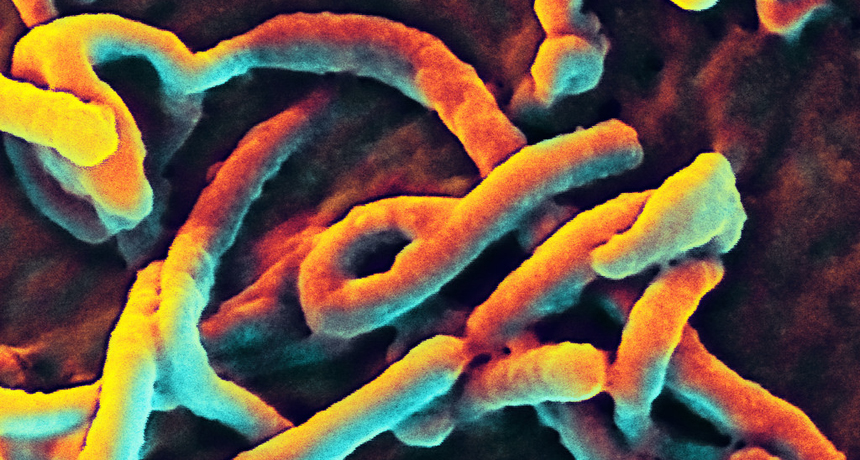News Brief: U.S. gets its first Ebola case
The patient had recently arrived by plane from West Africa

A scanning electron micrograph of Ebola viruses.
NIAID/Flickr (CC BY 2.0)
By Nathan Seppa
See update below
On September 30, doctors diagnosed the first case of Ebola in the United States. It was a man who had arrived in Texas from Liberia. That West African nation is where most cases of the viral disease have turned up so far during the current outbreak. The man felt well when he left Africa on September 19. His first symptoms only emerged 5 days later.
The man saw a doctor a few days after that. Doctors sent him to the hospital on September 28. There he was put in isolation. Doctors, who suspected he might have Ebola, sent a sample of his blood to the Centers for Disease Control and Prevention, or CDC, in Atlanta, Ga. CDC officials confirmed the man had Ebola on Tuesday afternoon.
Tom Frieden directs the CDC. “Ebola can be scary. But there’s all the difference in the world between the U.S. and parts of Africa where Ebola is spreading,” he says. “The United States has a strong health care system and public health professionals who will make sure this case does not threaten our communities,” he says. So even if additional cases show up during the coming weeks, he says, “I have no doubt that we will contain this.”
The infected patient has not been identified. He is being cared for at Texas Health Presbyterian Hospital in Dallas.At a Tuesday press briefing, Frieden said his agency and Texas health-care workers are now tracing everyone the patient may have contacted since his symptoms first appeared. This will include all family members he had visited and a “handful” of others.
Ebola is not contagious until someone shows symptoms, Frieden noted. He saids this means there is no risk that people who shared the man’s flights would have picked up the virus from him. In fact, people are now being screened for fever — an early Ebola symptom — before they are allowed to board an airplane leaving an affected African country. However, even when an infected person does start to show symptoms, he or she cannot infect another through a casual association. Ebola is spread through contact with bodily fluids (not through the air, as flu is).
There are several strains of the virus, named for where they first showed up. This is the first case of the Ebola-Zaire form of the virus to appear outside of Africa, Frieden says. The Dallas patient is “critically ill.” A CDC team is on its way to Texas to help trace the man’s contacts.
To date, CDC reports that 6,574 cases of known or suspected Ebola have turned up in Africa this year. Of them, 3,091 have died. However, CDC also suspects that the actual number of cases may be 2.5 times as high as the reported figures. In fact, a week before the Texas announcement CDC projected that the actual total number of Ebola infections might be hit 21,000 by September 30.
Update, October 8:
Today, the patient — now identified as Thomas Eric Duncan — died from Ebola at Texas Health Presbyterian Hospital, in Dallas. Before he was hospitalized, the man came into contact with dozens of people. At this time, another 48 individuals, including some family members and friends, are being watched. Health professionals have been checking twice daily with each. They will continue to do so for at least 21 days, looking for signs of possible symptoms. So far, none have emerged. The cost of caring for Ebola patients can be staggering. Bloomberg News cited one expert who estimated that “Duncan’s care probably costs $18,000 to $24,000 a day.” He was not insured, so the hospital will have to cover the costs of this patient’s treatment.
Power Words
Centers for Disease Control and Prevention, or CDC An agency of the U.S. Department of Health and Human Services, CDC is charged with protecting public health and safety by working to control and prevent disease, injury and disabilities. It does this by investigating disease outbreaks, tracking exposures by Americans to infections and toxic chemicals, and regularly surveying diet and other habits among a representative cross-section of all Americans.
Ebola A family of viruses that cause a deadly disease in people. Most cases occur in Africa and Asia. Its symptoms include headaches, fever, muscle pain and extensive bleeding. The infection spreads from person to person (or animal to some person) through contact with infected body fluids
infection A disease that can spread from one organism to another.
outbreak The sudden emergence of disease in a population of people or animals.
strain (in biology) Organisms that belong to the same species that share some small but definable characteristics. Certain bacteria, for example, may develop one or more mutations that turn them into a strain that is immune to the ordinarily lethal effect of one or more drugs.
virus Tiny infectious particles consisting of RNA or DNA surrounded by protein. Viruses can reproduce only by injecting their genetic material into the cells of living creatures. Although scientists frequently refer to viruses as live or dead, in fact no virus is truly alive. It doesn’t eat like animals do, or make its own food the way plants do. It must hijack the cellular machinery of a living cell in order to survive.







